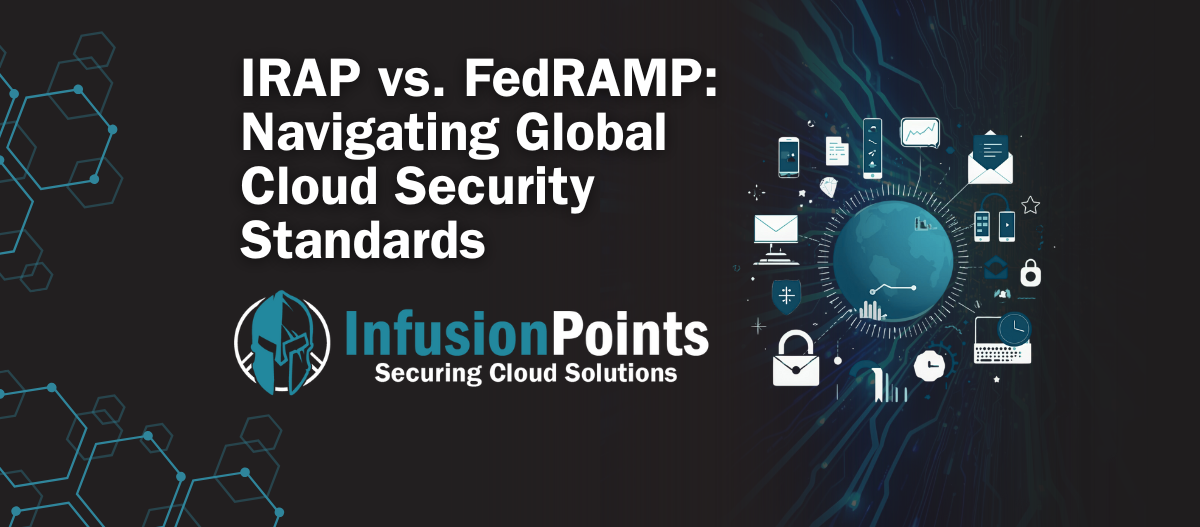IRAP vs. FedRAMP: Navigating Global Cloud Security Standards
Introduction
With the ever-growing global security landscape, security authorization programs such as FedRAMP and IRAP have become increasingly more important, especially for multinational Cloud Service Providers (CSPs) pursuing market opportunities in both the U.S. and Australia. With this in mind, it is more important than ever to understand the differences and similarities between FedRAMP and IRAP to work towards parity in CSPs’ service offerings to achieve maximum market differentiation and signal a mature security posture marketable in multiple jurisdictions.
FedRAMP
The Federal Risk and Authorization Management Program (FedRAMP) is a U.S. government initiative designed to standardize security for cloud services used by federal agencies. Governed by the FedRAMP PMO, GSA, DoD, and DHS, FedRAMP provides a centralized certification process that ensures cloud service providers (CSPs) meet stringent security requirements.
Its foundation lies in NIST SP 800-53 controls, and it offers a structured path to authorization, including preparation, assessment by a Third-Party Assessment Organization (3PAO), and continuous monitoring.
FedRAMP Impact Levels
Impact Level | Description | Approx. Controls | Key Technical Differences |
Low | Basic protection for public data | ~125 | Minimal encryption requirements; basic access control; limited audit logging |
Moderate | Sensitive but unclassified data | ~325 | FIPS 140-2 validated cryptography; multi-factor authentication; enhanced incident response and continuous monitoring |
High | High-value assets and mission-critical systems | ~421 | Stronger encryption standards; stricter physical and personnel security; advanced vulnerability scanning and remediation |
IL4 / IL5 | DoD-specific overlays for Controlled Unclassified Information (CUI) | Adds 20–30 | Additional DoD-specific controls; IL5 requires isolation from non-DoD tenants; enhanced supply chain risk management |
IRAP
The Information Security Registered Assessors Program (IRAP) is an Australian government framework managed by the Australian Signals Directorate (ASD). Unlike FedRAMP, IRAP does not certify services; instead, it provides an assessment mechanism to evaluate cloud services against the Australian Government Information Security Manual (ISM)
IRAP assessments are conducted by ASD-accredited assessors, and each Australian agency makes its own risk-based decision on whether to accept the results. This decentralized approach emphasizes flexibility but requires agencies to individually review compliance outcomes.
IRAP Classification Levels
Classification | Description | Approx. Controls | Key Technical Differences |
Unclassified / Official | Baseline for systems handling general government data | ~800 | Standard ISM controls; minimal jurisdictional or cryptographic restrictions |
Protected | Sensitive but unclassified (most common target) | ~940 | ASD-approved cryptographic algorithms; exclusive Australian legal jurisdiction; physical separation; personnel vetting and Australian citizenship; compliance with search/seizure laws |
Secret | Classified information requiring strict access | ~1003 | Enhanced encryption requirements; stricter access controls; mandatory secure facilities; higher personnel clearance |
Top Secret | Highest level of security; includes all ISM domains | ~1053 | Full ISM compliance; strongest cryptographic standards; compartmentalized access; stringent vetting and monitoring |
Similarities Between FedRAMP and IRAP
FedRAMP and IRAP share a common purpose: enforcing security standards for cloud services used by government entities. Both frameworks rely on rigorous control sets—FedRAMP leverages NIST SP 800-53, while IRAP uses the Australian Signals Directorate’s ISM. They mandate independent third-party assessments to validate compliance and emphasize critical security domains such as access control, encryption, incident response, and continuous monitoring. These shared principles ensure that cloud environments meet stringent security expectations regardless of jurisdiction.
Major Differences
Despite their shared goals, FedRAMP and IRAP differ significantly in structure and implementation. FedRAMP operates as a centralized certification program, granting reusable authorizations listed in the FedRAMP Marketplace for United States federal agencies, whereas IRAP functions as a decentralized assessment scheme where each Australian agency independently decides whether to accept the assessor’s findings. The process also varies: FedRAMP follows a structured path of preparation, assessment by a 3PAO, authorization, and continuous monitoring, while IRAP involves engagement with an assessor, evaluation against ISM controls, and agency review.
The frameworks diverge in impact levels as well—FedRAMP categorizes systems as Low, Moderate, or High, while IRAP aligns with Australian classifications from Unclassified to Top Secret. Portability is another key difference: FedRAMP authorizations can be reused across agencies, whereas IRAP assessments cannot. Finally, cryptographic requirements highlight a technical distinction: FedRAMP mandates FIPS 140-2 validated cryptographic modules, while IRAP requires ASD-approved algorithms and modules in accordance with Australian ISM standards.
Conclusion
FedRAMP and IRAP share a common mission: securing government cloud environments. However, their approach, jurisdictional requirements, and portability differ significantly. For global cloud providers, understanding these nuances is essential for compliance and market access.
InfusionPoints has experience guiding CSPs through both FedRAMP and IRAP processes and are more than happy to assist. Feel free to reach out to us with any questions you have.


